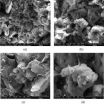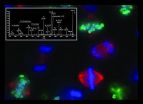(Press-News.org) Researchers from North Carolina State University have developed a computational tool designed to guide future research on biochemical pathways by identifying which components in a biological system are related to specific biochemical processes, including those processes responsible for gene expression, cell signaling, stress response, and metabolism.
"Our goal was to identify modules, or functional units, which are critical to the performance of the biochemical pathways that govern a host of biological processes," says Dr. Cranos Williams, an assistant professor of electrical and computer engineering at NC State and senior author of a paper describing the work.
"For example, a car has lots of modules – the parts that make it go, the parts that make it stop, the parts that let you steer, etc. If you understand those modules, you understand how the car works. But if you just have a list of parts, that's not very helpful.
"And what we have right now for many biochemical pathways is essentially just a list of parts – metabolites, biochemical reactions and enzymes that facilitate those reactions – and, in some cases, how those parts change over time. What we need is a clear understanding of which parts work together. That's where our new algorithm comes in."
The researchers developed an algorithm that allows them to identify which parts – the metabolites, reactions and enzymes – are related to each other and can be grouped into functional modules. The algorithm also identifies whether an individual component plays a role in multiple modules. For example, an enzyme may play a primary role in critical stress response pathways and a secondary role in processes associated with programmed cell maintenance or death.
The algorithm also characterizes how the relationships between different modules and individual components may change over time and under different internal and external conditions.
The input for the algorithm comes from using well-established dynamic models to observe changes in concentrations of metabolites, reactions and enzymes under various conditions. The algorithm then processes that data to establish primary and secondary relationships between all of the constituent parts.
"When modifying biological processes, there are thousands of possible combinations of metabolites, reactions and enzymes for any given biochemical pathway," Williams says. "Our work should help life scientists narrow down the list of key players in order to target their research efforts on functional groups that are most likely to improve our ability to understand and control important biological processes. This has applications in everything from biomedical research to agriculture to biofuels."
INFORMATION:
The paper, "Hierarchical Modularization Of Biochemical Pathways Using Fuzzy-C Means Clustering," is forthcoming from IEEE Transactions on Cybernetics. Lead author of the paper is Dr. Maria de Luis Balaguer, a former Ph.D. student at NC State.
Computational tool offers new insight into key biological processes
2014-03-06
ELSE PRESS RELEASES FROM THIS DATE:
Why soil changes color in air
2014-03-06
According to the results of a recent study, soil color changes in the atmosphere basically through the oxidation of chemical substances in the soil. The fundamental mechanism is the remodeling effect of micro-structures because of motion effects and chemical reactions of the water–soil–electrolyte–atmosphere system leading to the coupling and transforming of soil particles. The above provides a theoretical foundation for the assessment and forecast of the stability of the geotechnical environment.
Nowadays, with increasing focus on the harmful effects of fog and haze ...
Eating red and processed meat -- what do scientists say
2014-03-06
Oxford, March 6, 2014 -- Recent reports warn about a link between eating red and processed meat and the risk of developing cancer in the gut. These reports have resulted in new nutritional recommendations that advise people to limit their intake of red and processed meats. A recent perspective paper, authored by 23 scientists, published in the latest issue of journal Meat Science underlines the uncertainties in the scientific evidence and points to further research needed to resolve these issues and improve the foundation for future recommendations on the intake of red ...
Waiting for a donor heart: Motion prolongs survival
2014-03-06
For many people with advanced cardiac insufficiency, a heart transplant may be their only hope. e. But waiting for a donor heart to come along is a race against time. Patients who remains active and stay in good shape psychologically can significantly increase their chances of surviving this period. . Anxiety-ridden, depressive and passive patients, on the other hand, run the risk of further serious deterioration of their heart's ability to function.
This is what health psychologists at the universities of Luxembourg, Mainz and San Francisco found in a study conducted ...
Offshore dispersant data and decisions
2014-03-06
COLUMBIA, S.C. — Dispersants are often used in oil spill responses because they may mitigate the environmental impacts of the spill by moving the oil from the water surface into the water column enhancing its biodegradation. While this process helps reduce the likelihood of oil exposure to marine wildlife such as seabirds and marine mammals, aquatic toxicity on marine communities from the dispersant and the chemically dispersed oil needs to be considered more carefully.
Scientists at Research Planning, Inc. and HDR Ecosystem Management evaluated the standard toxicity ...
Researchers identify a critical link between obesity and diabetes
2014-03-06
BOSTON – It's by now well established that obesity is a major risk factor for diabetes. But what exactly is it about extra body fat that leads to insulin resistance and blood glucose elevation, the hallmarks of diabetes?
Over the past several years, Beth Israel Deaconess Medical Center (BIDMC) endocrinologist Barbara Kahn, MD, has developed a large body of research suggesting that a molecule called retinol binding protein 4 (RBP4) plays a key role in the process. Kahn's lab was the first to show that elevated levels of RBP4 – previously known only for its role as a ...
Strategies on the Internet to discredit generic drugs
2014-03-06
Although there is widespread consensus among the scientific community that the composition of generic drugs is identical to that of brand name drugs, this is not the case among the public. In a four-year study of over 3,000 opinions on Spanish web pages, researchers at the National University of Distance Education (UNED) of Spain have identified communication strategies aimed at creating risk perceptions about generic drugs, which may influence the low usage of these drugs.
Generic drugs, which are copies of brand name drugs whose patent has expired, have exactly the ...
New research could help make 'roll-up' digital screens a reality for all
2014-03-06
Researchers from the University of Surrey worked together with scientists from Philips to further develop the 'Source-Gated-Transistor' (SGT) - a simple circuit component invented jointly by the teams.
Previously, they found that the component could be applied to many electronic designs of an analog nature, such as display screens. Through this current study, researchers have now shown that SGTs can also be applied to next-generation digital circuits.
SGTs control the electric current as it enters a semiconductor, which decreases the odds of circuit malfunction, improves ...
Researchers capture 'most complete' picture of gene expression in cancer cell cycle
2014-03-06
Uncontrolled cell growth and division is a hallmark of cancer. Now a research project led by the University of Dundee has provided the most complete description to date of the gene activity which takes place as human cells divide.
Researchers have managed to gather data which details the behaviour of protein molecules encoded by over 6000 genes in cancer cells, as they move through the cell cycle. The team has used advances in technology and data analysis to study how genes work over time in cancer cells, as opposed to capturing a `snapshot' of activity – a leap forward ...
Sudden cardiac death: Genetic disease ARVC more common than hitherto assumed
2014-03-06
The genetic disease ARVC leads to sudden cardiac death and is more common than it has been hitherto assumed. This is reported by an international team of researchers headed by Prof Dr Hendrik Milting from the Heart and Diabetes Center NRW in the "European Heart Journal". The molecular biologist working at the Ruhr-Universität's clinic in Bad Oeynhausen revealed that all families who are known to be affected by the disease share the same genetic origin. There must be other families in Europe who also carry the genetic mutation but who are not yet known.
Mutation initially ...
Study suggests higher levels of omega-3 in diet are associated with better sleep
2014-03-06
A randomised placebo-controlled study by the University of Oxford suggests that higher levels of omega-3 DHA, the group of long-chain fatty acids found in algae and seafood, are associated with better sleep. The researchers explored whether 16 weeks of daily 600 mg supplements of algal sources would improve the sleep of 362 children. The children who took part in the study were not selected for sleep problems, but were all struggling readers at a mainstream primary school. At the outset, the parents filled in a child sleep questionnaire, which revealed that four in ten ...


